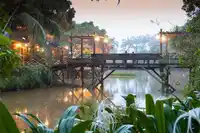
Danum Valley
One of the world’s best destinations for birding as well as seeing orangutans in the wild.
Explore Danum ValleyIndigenous tribes, playful primates and ancient emerald rainforests: the biodiverse island of Borneo is a veritable treasure trove of resource-rich natural attractions.
Indigenous tribes, playful primates and ancient emerald rainforests: the biodiverse island of Borneo is a veritable treasure trove of resource-rich natural attractions.
From the world’s oldest rainforest to craggy mountains, swamps, and valleys where wide rivers wind lazily toward the crystal waters of the South China Sea, these magical settings combine with Borneo’s tropical animals and laidback beach retreats to make the island a must on any wildlife-lover’s list.
Borneo has played a big role in the development of the theory of evolution. Scientists have been busy finding and naming new species here since Alfred Wallace developed his theories on natural selection in the 19th century. With such a mix of habitats and climates, Borneo has the ideal conditions for a huge variety of species to thrive throughout its rainforests, swamps and mangroves. The island plays host to an enormous assortment of uniquely endangered wildlife, such as the charming and gentle orangutan, noisy proboscis monkey, diminutive pygmy elephant and elusive but stunningly beautiful clouded leopard. Flora and fauna abound in this Eden-like sanctuary, with a staggering 15,000 species of flowering plants and 3,000 species of tree, in addition to rare orchids, 12 species of rafflesia (the world’s largest flower) and in excess of 600 bird species. All of this contributes to what is an incredibly diverse area and makes for the ultimate Borneo holiday
As the jungle awakens with the calls and chatter of wild animals, you catch a glimpse of bright orange hair through the emerald-green rainforest, covering lithe and dextrous limbs and a pensive face which lives up to the name “man of the forest”. The orangutan is the epitome of any Borneo wildlife holiday. With grasping hands and feet as well as long arms that may reach two metres in length, the orangutan swings slowly through the tree canopy of Borneo. When night approaches they make nests of vegetation in which to sleep. Spotting orangutans in the wild can be hard work, but it is always worth it to see them in their natural habitat. We also give clients the opportunity to visit the Sepilok Rehabilitation Centre, where injured and orphaned orangutans are nursed back to health so they can be reintroduced into the wild. Seeing orangutans here may not match the thrill of spotting them in the wild, and we wouldn’t suggest it as an alternative, but the opportunity to see them in close proximity is not to be missed. Visiting the Centre will contribute to this vital conservation project and complement your encounters with wild orangutans.
The smallest and most arboreal of all bear species, the sun bear is difficult to study in the wild and is threatened by deforestation and the illegal wildlife trade. Sun bears get their name from the pale crescent-shaped patch of fur on their chest, which is said to resemble the rising sun. They are also sometimes known as honey bears due to their predilection for raiding beehives. Sun bears occur at low densities and can be difficult to spot in the wild, but by visiting the biodiversity hotspot of Danum Valley you can get the chance to look for these fascinating animals both on the ground and in the trees. They are largely nocturnal, so if you have your heart set on spotting one, join your guide as night falls and venture into the rainforest with torch in hand. Guaranteed sun bear sightings can be had at the Bornean Sun Bear Conservation Centre, in Sandakan. Here ex-captive bears are raised and cared for in safe conditions that will prepare them for an eventual return to the wild. Though the bears are unable to roam through the nearby Kabili-Sepilok Forest Reserve for their own safety, it is a joy to see them revelling in their natural habitat after having endured the terrors of their past.
The smallest and most secretive of all elephants, the Borneo pygmy elephant is a forest-dwelling subspecies of the Asian elephant. They are said to have a gentle nature and can sometimes be found bathing in rivers. Seeing one is a real treat. Generally measuring between 5 and 8 ft in height, Borneo’s elephants are on average about 25% smaller than other Asian elephants. Their diminutive size is matched by the lower aggression that these pachyderms exhibit towards their own kind and other species. Boat journeys along the Kinabatangan River are one of the best ways to spot wildlife in Borneo, and elephants can certainly make an appearance amongst the various birds, monkeys and aquatic creatures that call the Kinabatangan home. Small herds and solitary males come to the river to drink, bathe, and cool off from the heat. Mothers can sometimes be seen helping their calves to climb the muddy riverbanks.

One of the world’s best destinations for birding as well as seeing orangutans in the wild.
Explore Danum Valley
Best known for its groundbreaking work in protecting these much-loved primates.
Discover the Sanctuary
At 130 million years old, Borneo's Rainforest is one of the oldest in the world, and home to a dizzying number of species (15,000 of plants, 3,000 of trees, 221 of land mammals & 420 of birds!). As the third largest island in the world, a lot of these are endemic to Borneo alone, their natural habitat being unique and endangered. The renowned Danum Valley is a mystical and special example of this pristine environment, where you can spot a variety of Borneo's animals including, pygmy elephants and (if you are very lucky) clouded leopard skulking in the shade of lowland dipterocarps, watch orangutans and gibbons swinging in the vines, and bearded pigs and deer scarpering through the undergrowth.
Read about Borneo Rainforests
Wong Siew Te is a Malaysian wildlife biologist and sun bear expert. He has been studying Bornean sun bears since 1998 in Sabah, Malaysian Borneo.
Read about Wong Siew Te
Seeing orangutans in the wild is one of the most magical experiences in Borneo. Find out where the best place is to see orangutans in the wild in Borneo and Sabah.
Read more...
Borneo Rainforest Lodge is set in the fauna and flora rich Danum Valley; this rustic lodge is the perfect place to stay on a selection of bespoke Borneo holidays. The spacious main building offers an open veranda where the traveller can sit back and enjoy the incredible diversity of this forest environment whilst wooden chalets and bungalows provide comfortable lodgings for guests. The mist shrouded treetops and babbling river lull one to sleep after a day's wildlife spotting.
Read more...
Surrounded by thick jungle, the wooden chalets provide great access to the rehabiliation centre.
Lodge Details
Crocodiles lurk within Borneo’s many rivers, but on land, the largest predator you’ll encounter is a cat just over 6 ft from nose to tail. Little is known about the Sunda clouded leopard and sighting one of these secretive felines is a real rarity. The Sunda clouded leopard has the rare distinction of being one of the few carnivorans discovered in the 21st century. Take “discovered” with a grain of salt, however: scientists were well aware of their existence, but prior to 2007, it was thought that the clouded leopards living in Borneo and Sumatra were the same species as those living across a number of other areas in Southeast Asia, all the way up to the Himalayan foothills. Clouded leopards generally weigh between 12 and 26kg. These cats are named after the distinctive “clouds” on their coat, have an exceptionally long tail for balancing, can descend tree trunks head-first, and even climb while hanging upside down under branches. Clouded leopards are nocturnal and elusive creatures that are rare to see on safari. Your best chance lies in a visit to the Deramakot Forest Reserve, thought by some to be the best place in all of Asia for clouded leopard sightings.
Hornbills are Borneo’s most extravagantly adorned birds. Eight species can be found on the island, with the rhinoceros hornbill being the most well-known. This particular species appears on some Malaysian currency and is the country’s national bird. Rhinoceros hornbills can be found all across Borneo. Look for openings in the forest canopy, such as the mud volcano at Tabin Wildlife Reserve. Sightings are also likely when travelling along the Kinabatangan River, as the birds can be seen perching on treetops or flying overhead. The rhinoceros hornbill is the largest of Borneo’s eight hornbill species, with a wingspan of 5-6 ft. They are truly magnificent to watch in flight.

Join us on this photographic safari, specialist-led by a seasoned professional in the realm of photography, Charlie Ryan. Capturing the essence of Borneo’s wildlife through his lens, Charlie’s work has been published in National Geographic, BBC, and Netflix.

From swinging orangutans and honking proboscis monkeys, to sandy beaches and exploring the jungle; this safari is perfect for families with just the right mix of wildlife, relaxation and adrenaline.
From 7000 per person
Begin you luxury Borneo adventure by venturing into the rainforests and along the river in search of proboscis monkeys, orangutans and pygmy elephants, before ending your journey relaxing on the white-sand beaches of Pulau Tiga.A wild adventure into Borneo’s jungles in search of the fascinating wildlife that call it home; from swinging orangutans to honk-nosed proboscis monkeys.
From 17500 per person